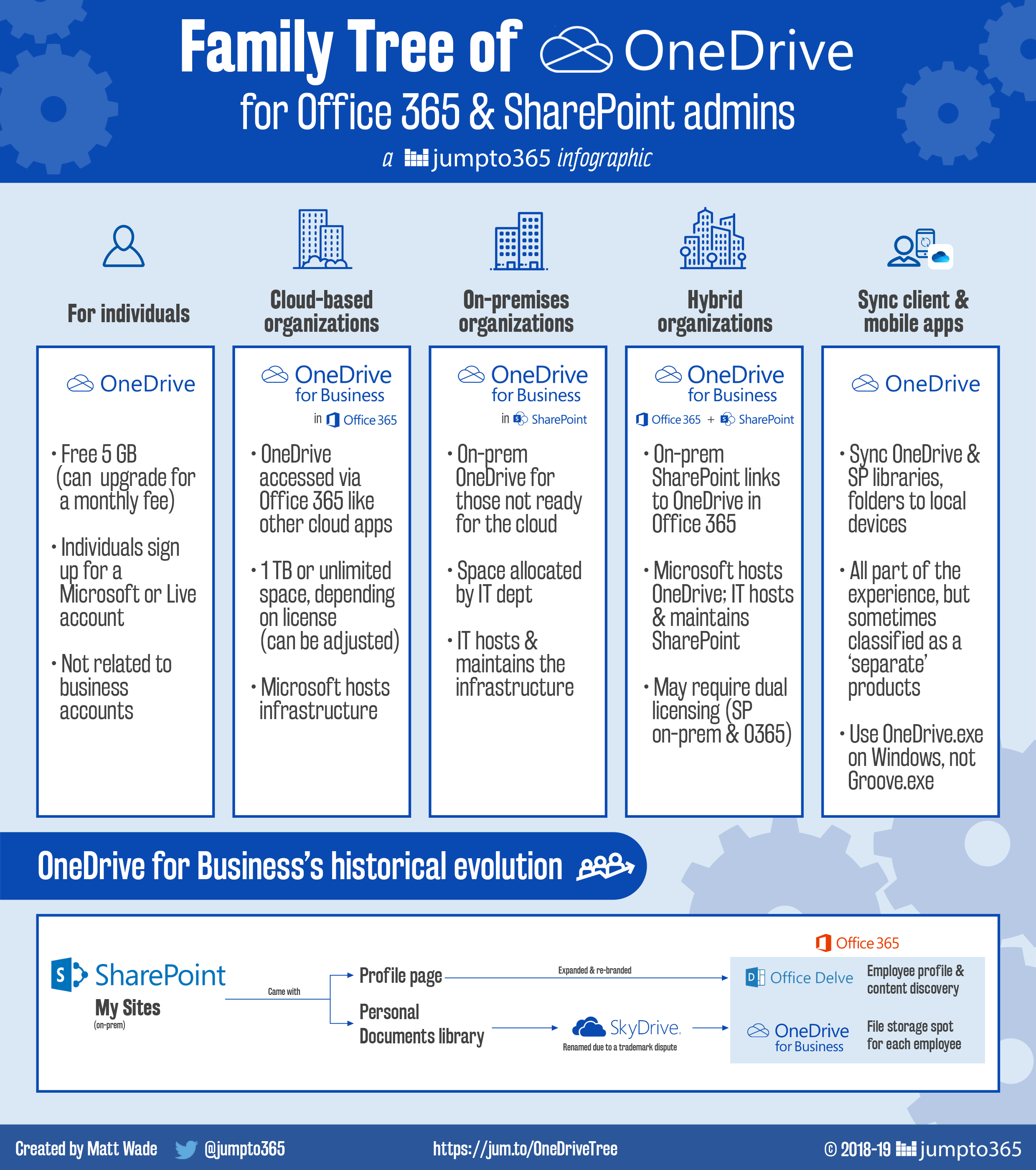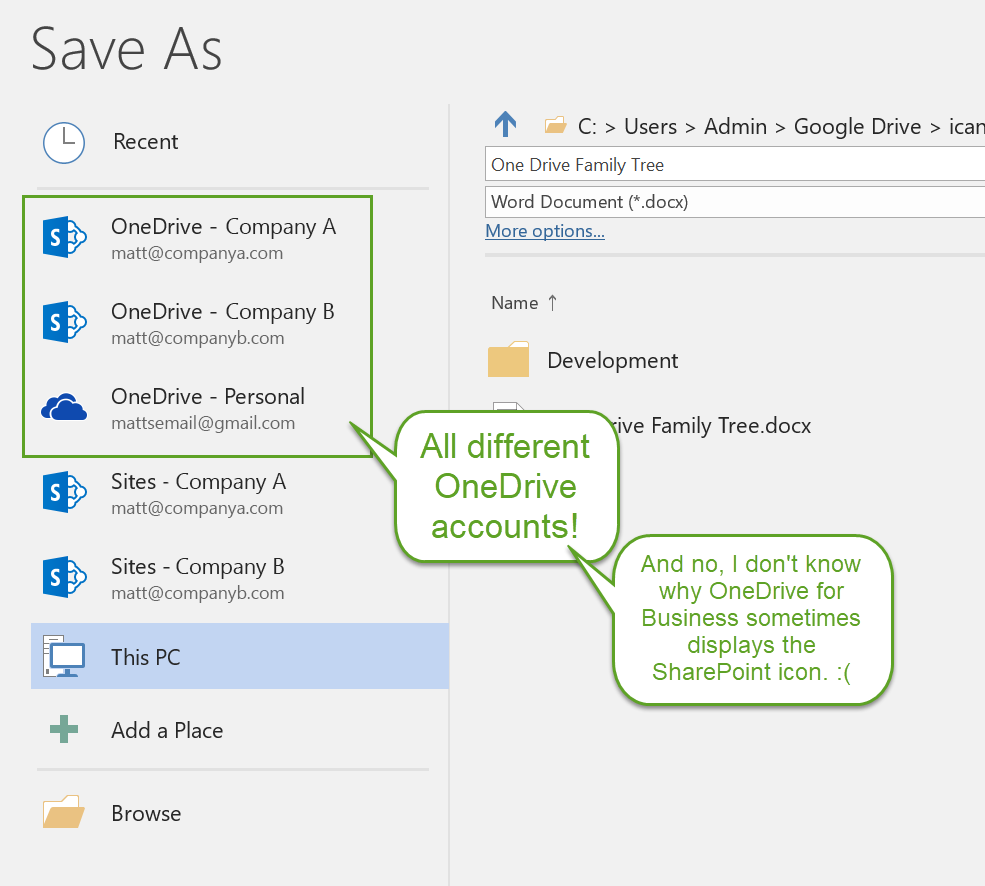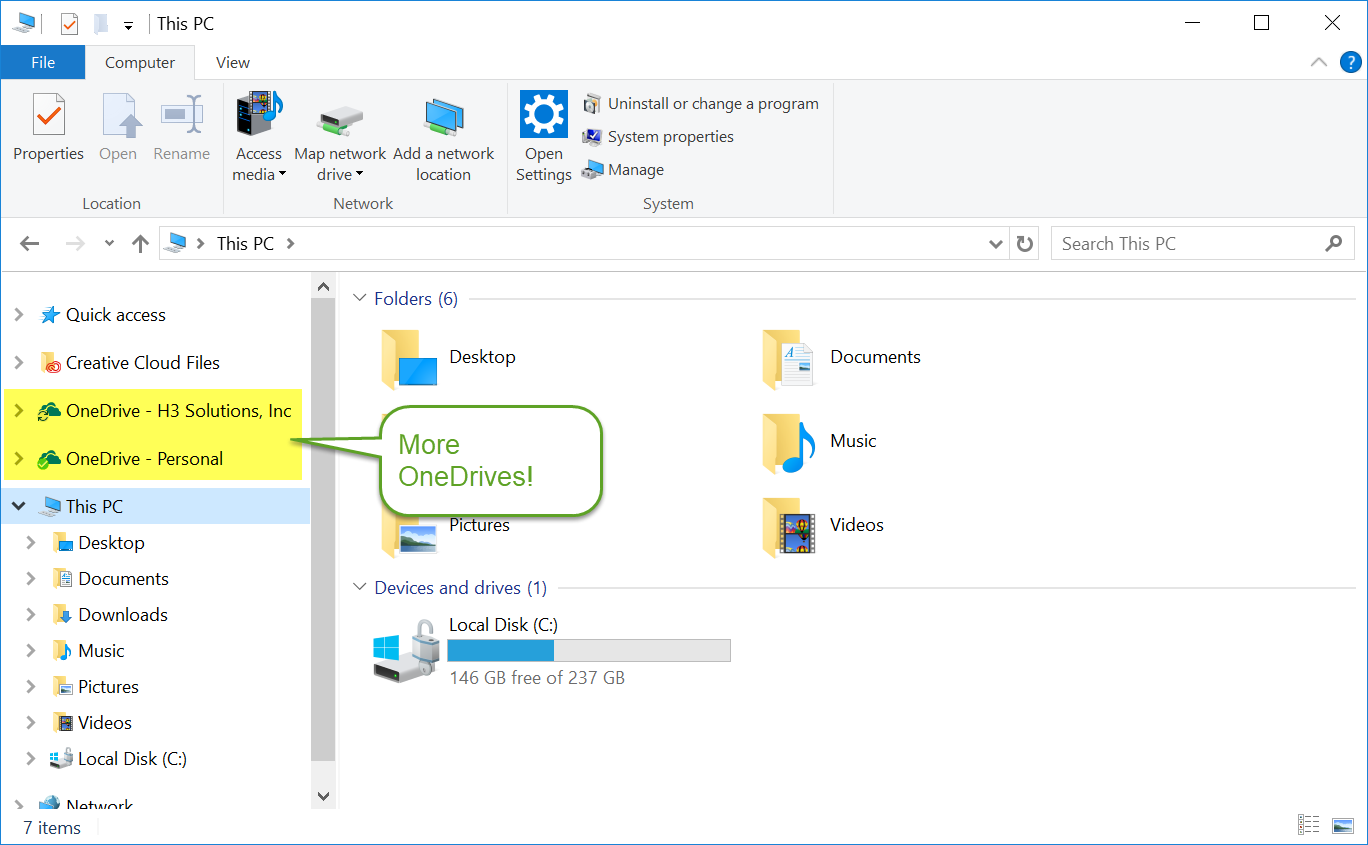One topic that I constantly see confusion around is the difference(s) between the multiple OneDrive experiences that exist within theMicrosoft platforms. Generally, this question comes up among everyday users and the IT folks who run the Office 365/OneDrive systems get hit with these questions on the regular.
Unlike most of my infographics, this one is targeted atOffice 365/OneDrive administrators, but it can also be useful for savvy users who just need a clear way to decipher which OneDrive experience is which.

The trouble
It happens to us all: you’re working on a Word document and want to save it. You haven’t gotten the finishing touches on it yet, so you want to avoid your team’s SharePoint site or shared drive and prevent any premature views or edits. But you want it to be readily available on all your devices.
Easy: use OneDrive. So you go to the save window in Word and get presented with… sometimes multiple OneDrive options. And, uh oh, sometimes OneDrive even has the wrong icon, so it’s even more confusing.

Then there’s the multiple clouds you see in your task bar. One’s blue, one’s white. A third might even be a light blue.

And the ones you may see in Windows Explorer.

These represent different ways to access only a couple different OneDrive accounts that, yes, are separate things. It’s important to know the difference. Blindly picking one over another could lead to misplaced files and unintended deletions based on company policy (or, you know, if you leave that company, since you lose access upon termination).
OneDrive
OneDrive—just OneDrive—is the consumer storage space that comes with any Microsoft or Live account. You get 5 GB of space for free and you can purchase more space if you’d like. This account is a personal account; it’s comparable to a Google Drive that comes with a Gmail/Google account.
What’s important to note is a OneDrive typically has no connection to your work account’s OneDrive for Business, and your employer’s IT team is not going to have much to say if you have issues with this personal account. It’s yours, it’s free, and it’s optional to use.
That said, when purchasing a new Windows 8 or 10 PC or laptop these days, Microsoft generally asks you to create a Microsoft account when first booting. Whether you knew it or not, you got a OneDrive with that account. That’s why you might see one from the start of using a new device.
OneDrive for Business
OneDrive for Business (OD4B) is the commercial app that comes with your work account. Depending on your license type, you might have 1TB of space or unlimited space you can use, though IT departments who run Office 365 systems are able to shrink that down to something a bit more reasonable.
(Let’s be real, if you’re using a full TB of space[equivalent of 213 DVDs] on your OD4B, it’s likely not for good—or legal—reasons; torrent repository anyone?)
OD4B in Office 365 is a cloud product. Your content is stored on Microsoft servers.
OD4B is also available for systems that are hosted locally, on-premises (on-prem). In that instance, the content is stored on locally owned servers, and not in Microsoft’s cloud. OD4B on-prem is usually used by organizations that aren’t yet comfortable with or can’t support a move to the cloud. OD4B on-prem is more a rebrand of the older SharePoint My Sites, which used to come with a personal documents library for storing files. Size limits are dictated by IT, who will have limited server space to share among users (as in, it’s rare for companies to provide the 1 TB of space per individual thatMicrosoft can because it’s expensive).
There are a number of ways OD4B can be implemented in conjunction with SharePoint:
- You can be fully cloud, with OD4B and SharePointOnline both being in Office 365. This is the simplest implementation and requires little more than a monthly fee per user to access.
- You can be fully on-prem, with OD4B andSharePoint (2013 or 2016) both being hosted on local servers. This is the most complex implementation and requires hardware and software support (plus maintenance!) with likely less space availability than Office 365.
- You can be hybrid with OD4B in the cloud andSharePoint on-prem. This provides easy and spacious administration of OD4B with the benefits of SharePoint on-prem in situations where more formal (SharePoint)content needs to remain on-prem for logistical, legal, or compliance reasons.
- You can be hybrid with OD4B on-prem andSharePoint Online being in Office 365. I honestly can’t think of a reason to implement this hybrid scenario, but theoretically it’s possible.
Sync clients
The OneDrive experience also comes with a sync client, which lets you download your files for offline access. This is extremely useful for individuals who travel a lot or have poor data or wifi options where they work.The most recent version of the sync client lets you save some or all OneDrive files on your local PC as well as whole document libraries from SharePointOnline or SharePoint 2016.
The sync client is great for getting work done while you’re not connected to the internet. Enable syncing and OneDrive will keep copies of files or folders on your device using the built-in client in Windows 8/10 orMacOS. Once you re-enter a wifi zone, any changes to your files will automatically upload to OD4B or SharePoint and update the ‘master’ file with your changes. Note, this means co-authoring is not available while you’re offline.
In addition to the obvious working-on-a-plane or no-wifi situations, this is extremely handy when you run into wifi issues say, at a coffee shop that you’re working remotely at or, especially, when you’re about to give a presentation at a new location where you’ve never accessed the wifi before. Having that local copy is a GODSEND.
That said, the sync client has a rough history. An earlier version, known as Groove.exe, was known for being poor at actually performing syncs and sharing updates. The current version, known as the NextGeneration Sync Client (NGSC), or OneDrive.exe, works significantly better and supports SharePoint syncing and Files on Demand (the latter basically shows you all your files in FileExplorer even if they haven’t been downloaded as opposed to only the files and folders you’ve already synced).
And no, I’m not sure what they’ll call the next NextGeneration Sync Client. N2GSC maybe?
There’s a lot to be familiar with if you’re moving to NGSC or troubleshooting Groove.exe. I suggest reading the technical overview here, this help/opinion piece by John White here, and Paul Cunningham’s coverage on some situations where the old client is still required.
Mobile
The OneDrive app provides access to your OneDrive, OneDrive for Business, and SharePoint files from a single point of entry on your iOS or Android device.There is no OneDrive for Business app; all OneDrive work goes through the single app, so you only have to download the one app, no matter which platform you’re using.
Even SharePoint files opened from the SharePoint app will be accessible via OneDrive, which is actually quite handy. (So handy, in fact, I find little reason to even need the SharePoint mobile app.)
Conclusion
Hopefully this helps explain the different OneDrive experiences, because it can get confusing, even for the IT folks out there. If you have any questions or suggestions, feel free to comment on Twitter @jumpto365!





Obviously you have an opinion, so share it!